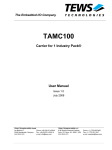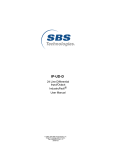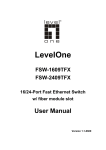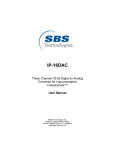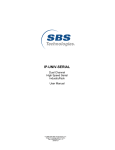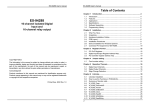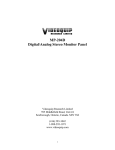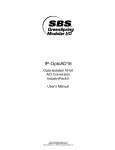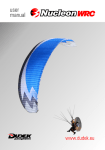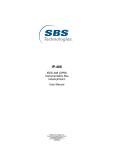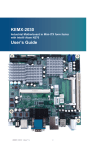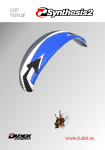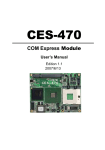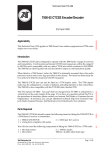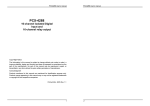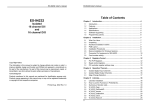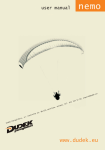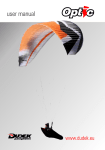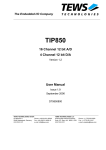Download SBS / GE Fanuc MC-303 User Manual
Transcript
Artisan Technology Group is your source for quality new and certified-used/pre-owned equipment • FAST SHIPPING AND DELIVERY • TENS OF THOUSANDS OF IN-STOCK ITEMS • EQUIPMENT DEMOS • HUNDREDS OF MANUFACTURERS SUPPORTED • LEASING/MONTHLY RENTALS • ITAR CERTIFIED SECURE ASSET SOLUTIONS SERVICE CENTER REPAIRS Experienced engineers and technicians on staff at our full-service, in-house repair center WE BUY USED EQUIPMENT Sell your excess, underutilized, and idle used equipment We also offer credit for buy-backs and trade-ins www.artisantg.com/WeBuyEquipment InstraView REMOTE INSPECTION LOOKING FOR MORE INFORMATION? Visit us on the web at www.artisantg.com for more information on price quotations, drivers, technical specifications, manuals, and documentation SM Remotely inspect equipment before purchasing with our interactive website at www.instraview.com Contact us: (888) 88-SOURCE | [email protected] | www.artisantg.com MC-303 Three Slot PC•MIP Carrier for 3U CompactPCI with Front and Rear Panel I/O User Manual ©SBS Technologies, Inc. Subject to change without notice. Part Number: 89004565 Rev. 6.0 Hardware Revision: A 20050113 Artisan Technology Group - Quality Instrumentation ... Guaranteed | (888) 88-SOURCE | www.artisantg.com MC-303 Three Slot PC•MIP Carrier for 3U CompactPCI with Front and Rear Panel I/O SBS Technologies, Inc. 1284 Corporate Center Drive St. Paul, MN 55121-1245 Tel: (651) 905-4700 FAX: (651) 905-4701 Email: [email protected] http://www.sbs.com ©1999, 2003, 2005 SBS Technologies, Inc. IndustryPack is a registered trademark of SBS Technologies, Inc. QuickPack, SDpacK and Unilin are trademarks SBS Technologies, Inc. PC•MIP is a trademark of SBS Technologies, Inc. and MEN Mikro GmbH. SBS Technologies, Inc acknowledges the trademarks of other organizations for their respective products mentioned in this document. All rights are reserved: No one is permitted to reproduce or duplicate, in any form, the whole or part of this document without the express consent of SBS Technologies, Inc. This document is meant solely for the purpose in which it was delivered. SBS Technologies, Inc. reserves the right to make any changes in the devices or device specifications contained herein at any time and without notice. Customers are advised to verify all information contained in this document. The electronic equipment described herein generates, uses and may radiate radio frequency energy, which can cause radio interference. SBS Technologies, Inc. assumes no liability for any damages caused by such interference. SBS Technologies, Inc.’s products are not authorized for use as critical components in medical applications such as life support equipment, without the express consent of the president of SBS Technologies Commercial Group. This product has been designed to operate with IndustryPack, PC•MIP or PMC modules or carriers and compatible user-provided equipment. Connection of incompatible hardware is likely to cause serious damage. SBS Technologies, Inc. assumes no liability for any damages caused by such incompatibility. Artisan Technology Group - Quality Instrumentation ... Guaranteed | (888) 88-SOURCE | www.artisantg.com Table of Contents PRODUCT DESCRIPTION................................................................................................. 1 KEY FEATURES .................................................................................................................. 1 PC•MIP INSTALLATION AND REMOVAL........................................................................ 2 OVERVIEW......................................................................................................................... 2 INSTALLATION OF TYPE I AND TYPE U MODULES.................................................................. 2 INSTALLATION OF TYPE II MODULES .................................................................................... 2 REMOVAL OF TYPE I AND TYPE U MODULES ........................................................................ 3 REMOVAL OF TYPE II MODULES .......................................................................................... 3 PC•MIP SLOTS .................................................................................................................. 4 OVERVIEW......................................................................................................................... 4 PCI SLOTS ........................................................................................................................ 4 PCI TO PCI BRIDGE ........................................................................................................... 5 CONNECTORS................................................................................................................... 6 OVERVIEW......................................................................................................................... 6 J1 ..................................................................................................................................... 7 J2 ..................................................................................................................................... 8 P1, P2 .............................................................................................................................. 9 FUSES .............................................................................................................................. 11 PC•MIP GLOSSARY........................................................................................................ 12 SPECIFICATIONS ............................................................................................................ 16 REPAIR............................................................................................................................ 17 SERVICE POLICY.............................................................................................................. 17 Artisan Technology Group - Quality Instrumentation ... Guaranteed | (888) 88-SOURCE | www.artisantg.com List of Figures FIGURE 1 FIGURE 2 FIGURE 3 FIGURE 4 FIGURE 4A FIGURE 5 FIGURE 6 FIGURE 7 FIGURE 8 FIGURE 9 FIGURE 10 PC•MIP SLOT ASSIGNMENTS .............................................................................. 4 PC•MIP SLOT COMPATABILITY SUMMARY ............................................................ 4 PCI SLOT CAPABILITY SUMMARY ......................................................................... 5 PCI CONFIGURATION REGISTERS: 21152 AB BRIDGE CHIP.................................. 5 PCI CONFIGURATION REGISTERS: 21152 BB BRIDGE CHIP ............................... 5 CONNECTOR SUMMARY ....................................................................................... 6 CONNECTOR J1 COMPACTPCI BUS PIN ASSIGNMENT ........................................... 7 CONNECTOR J2 PC•MIP PIN ASSIGNMENT .......................................................... 8 CONNECTOR P1 PIN ASSIGNMENTS ..................................................................... 9 CONNECTOR P2 PIN ASSIGNMENT ..................................................................... 10 FUSES FITTED ............................................................................................... 11 Artisan Technology Group - Quality Instrumentation ... Guaranteed | (888) 88-SOURCE | www.artisantg.com Product Description The MC-303 is a 3U CompactPCI PC·MIP® carrier board. It has three PC·MIP slots, providing up to 150 lines of I/O: one front panel only I/O slot supporting Type II PC•MIP modules, one front or rear panel I/O slot supporting Type I or Type II PC•MIP modules, and one rear panel only I/O slot supporting Type I PC•MIP modules. Using the industry standard Intel 21152 PCI to PCI Bridge, the MC-303 supports a 32-bit data path at 33 MHz, for 132 MB/s operation. All PC•MIP slots support bus mastering. The MC-303 carrier board complies with the PICMG 2.0, version 2.1 CompactPCI specification and each PC•MIP slot is compatible with the PC•MIP draft specification (ANSI/VITA-29). Key Features • 3U CompactPCI carrier board holds up to three PC•MIP modules • Intel 21152 PCI to PCI Bridge • 32-bit, 33 MHz, up to 132 MB/s operation • PC•MIP draft specification (ANSI/VITA-29) compatible • PCI Specification, Revision 2.1 compliant • CompactPCI specification, PICMG 2.0, version 2.1 compliant • One front panel I/O slot supporting Type I or Type II modules • One front panel I/O slot supporting Type II modules only • One rear panel I/O slot supporting Type I modules only • 100 I/O lines via rear panel J2 CompactPCI connector 1 Artisan Technology Group - Quality Instrumentation ... Guaranteed | (888) 88-SOURCE | www.artisantg.com PC•MIP Installation and Removal Overview The PC•MIP front panel hardware has been designed so that the front panel itself need never be removed from the carrier board. In order to accommodate modules with different I/O requirements, holes in the front panel contain removeable bezels. These bezels are replaced as modules are installed and removed. A small keeper affixed with a single screw to the carrier board holds each bezel in place. PC•MIP carriers are shipped with a set of blank bezels and keepers sufficient to handle any combination of single- or double-wide modules. Type II modules (those with front panel I/O) are shipped with bezels machined for their specific I/O connector configuration. Type I and Type U modules (those without front panel I/O) are shipped without bezels. Installation of Type I and Type U Modules Type I and Type U modules have no front-panel I/O. Installation requires a small screwdriver. If the slot has front panel access and does not have a blank bezel in place, one should be fitted before installing the module. Slide the blank bezel into place from the outside of the front panel. Push the keeper through the front panel from the outside, and fit the screw into the keeper from the solder side of the carrier. Tighten the screw. Gently push the module down into its slot. The screws on the back of the module will prevent it from clicking into place. Single-wide modules have two screws. Double-wide modules have four. Using the small screwdriver, turn the screws clockwise. Doing so will pull the module down into its slot. Tighten the screws. The four screws on double-wide modules must be tightened carefully and in sequence to avoid excessive flexing of the PCB. Tighten the screws one turn at a time, moving to the next screw in a clockwise fashion around the board until all the screws have been tightened. Installation of Type II Modules Type II modules have front-panel I/O. They are supplied with a bezel that must be fitted into the front panel after the module is installed. Installation requires a small screwdriver. Remove any existing bezel from the front panel. Do so by unscrewing the single screw on the solder side of the carrier board that holds the small keeper in place. Push the keeper out through the front panel and slide the bezel out. Poke the I/O connector on the module through the bezel hole. Then gently push the module down into its slot. The screws on the module will prevent it from clicking into place. Single-wide modules have two screws. Double-wide modules have four. The four screws on double-wide modules must be tightened carefully and in sequence to avoid excessive flexing of the PCB. Tighten the screws one turn at a time, moving to the next screw in a clockwise fashion around the board until all have been tightened. Using the small screwdriver, turn the screws clockwise. Doing so will pull the module down into the slot. Tighten the screws. Slide the module bezel into place from the outside of the front panel. Push the keeper through the front panel from the outside, and fit the screw into the keeper from the solder side of the carrier. Tighten the screw. If provided, fit hardware to attach the module bezel to the module. 2 Artisan Technology Group - Quality Instrumentation ... Guaranteed | (888) 88-SOURCE | www.artisantg.com Removal of Type I and Type U Modules Type I and Type U modules have no front-panel I/O. Removal requires a small screwdriver. Using the small screwdriver, turn the screws on the back of the module counterclockwise. Single-wide modules have two screws. Double-wide modules have four. Doing so will push the module up out of its slot. Because the screws are captive, they cannot be loosened too far. The four screws on double-wide modules must be loosened carefully and in sequence to avoid excessive flexing of the PCB. Tighten the screws one turn at a time, moving to the next screw in a clockwise fashion around the board until all the screws have been released. Using fingers, lift the module out of its slot. Removal of Type II Modules Type II modules have front-panel I/O. The module bezel must be removed before removing the module. Removal requires a small screwdriver. If the module has hardware that attaches it to the front panel bezel, remove that hardware first. Next, remove the module bezel. To remove the module bezel, unscrew the single screw on the solder side of the carrier board that holds the small keeper in place. Push the keeper out through the front panel and slide the bezel out. Using the small screwdriver, turn the screws on the back of the module counterclockwise. Single-wide modules have two screws. Double-wide modules have four. Doing so will push the module up out of its slot. The screws are captive, so they cannot be loosened too far. The four screws on double-wide modules must be loosened carefully and in sequence to avoid excessive flexing of the PCB. Tighten the screws one turn at a time, moving to the next screw in a clockwise fashion around the board until all have been released. Using fingers, lift the module out of its slot. Pull it out of the front panel hole. Store the module with its bezel. If the slot is to remain empty or is to accept a Type I or Type U module, fit a blank bezel to the front panel. To do this, slide the blank bezel into place from the outside of the front panel. Push the keeper through the front panel from the outside, and fit the screw into the keeper from the solder side of the carrier. Tighten the screw. 3 Artisan Technology Group - Quality Instrumentation ... Guaranteed | (888) 88-SOURCE | www.artisantg.com PC•MIP Slots Overview Three PC•MIP slots are provided, as shown in the figure below: Slot 5 J2 Slot 6 PC·MIP Type I or II Slot 4 PCIPC·MIP to PCI Bridge J1 Type I PC·MIP Type II Figure 1 PC•MIP Slot Assignments Each slot has front and back-panel I/O access as shown in the table below: Module Slot Type I 4 5 Yes 6 Yes Figure 2 Front panel I/O Back panel I/O Type II Location Location Yes On module Yes On module J2 J2 PC•MIP Slot Compatability Summary Type I modules may be plugged into slots 5 or 6 only. All I/O is via the PCI back panel J2 connector. Type II modules may be plugged into slots 4 or 5 only. Slot pair 4-5 also supports doublewide Type II modules. Type U modules may be plugged into any slot since they have no I/O requirements. Double-wide Type U modules may be plugged into slot pair 4-5. PCI Slots Each PC•MIP slot is a hard-wired PCI slot. Its physical slot number and bus-mastering capabilities are fixed, as shown in the table below: 4 Artisan Technology Group - Quality Instrumentation ... Guaranteed | (888) 88-SOURCE | www.artisantg.com Figure 3 Slot Number Bus Master 4 Yes 5 Yes 6 Yes PCI Slot Capability Summary PCI to PCI Bridge The PCI bridge chip, an Intel 21152, is a transparent 32-bit, 33 MHz device. All PC•MIPs on the carrier are visible to the system CPU. The wiring of the bridge to the PC•MIP slots controls the mapping of PCI slot numbers to physical slots. PCI slot numbers start at 4. The bridge implements the interrupt mapping for the PC•MIP slots. This mapping is defined by the PCI specification. The bridge implements the bus mastership control for the PC•MIP slots. A two-level round-robin arbiter selects one master from among the three slots 4 through 6 and the host PCI bus. The table below shows the salient configuration registers: Location Value Description Vendor ID 0x1011h Intel, the manufacturer of the chip Device ID 0x0024h 21152 PCI to PCI Bridge chip Revision 0x05h 21152 chip revision Figure 4 PCI Configuration Registers: 21152 AB Bridge Chip Please note that revision 21152AB of the PCI bridge chip used on this card is now obsolete. Future versions of the card will use version 21152BB of the PCI bridge chip. The 21152BB is backwards compatible with the 21152AB and has been validated by SBS. It, however, has different vendor, device and revision IDs. If you card is fitted with the 21152BB, please use the following vendor, device, and revision IDs for configuration. Location Value Description Vendor ID 0x8086h Intel, the manufacturer of the chip Device ID 0xB152h 21152 PCI to PCI Bridge chip Revision 0x00h 21152 chip revision Figure 4A PCI Configuration Registers: 21152 BB Bridge Chip 5 Artisan Technology Group - Quality Instrumentation ... Guaranteed | (888) 88-SOURCE | www.artisantg.com Connectors Overview Connectors are fitted as shown in the table below: Connector J1 J2 PA1, PA2 PB1, PB2 PC1, PC2 PB3 PC3 Wired To PCI Bridge PB3, PC3 PCI Bridge PCI Bridge PCI Bridge J2 J2 Figure 5 Description 32-bit CompactPCI bus Back-panel I/O for PC•MIP slots 5 and 6 PCI bus for slot 4 PCI bus for slot 5 PCI bus for slot 6 Back-panel I/O for PC•MIP slot 5 Back-panel I/O for PC•MIP slot 6 Connector Summary 6 Artisan Technology Group - Quality Instrumentation ... Guaranteed | (888) 88-SOURCE | www.artisantg.com J1 J1 connects the carrier board to the CompactPCI backplane. Figure 6 below lists its pin assignments. Row Position A B C D E F 25 24 23 22 21 20 19 18 17 16 15 14 13 12 11 10 9 8 7 6 5 4 3 2 1 +5V AD01 +3V AD07 +3V AD12 +3V SERR# +3V DEVSEL# +3V Key Key Key AD18 AD21 CBE3# AD26 AD30 REQ# N/A N/A INTA# TCK +5V REQ64# +5V AD04 GND AD09 GND AD15 GND SDONE GND FRAME# Key Key Key AD17 GND IDSEL GND AD29 GND N/A GND INTB# +5V -12V ENUM# VIO AD03 +3V AD08 VIO AD14 +3V SBO# VIO IRDY# Key Key Key AD16 +3V AD23 VIO AD28 +3V RST# VIO INTC# TMS TRST# +3V AD00 +5V AD06 M66EN AD11 GND PAR GND STOP# GND Key Key Key GND AD20 GND AD25 GND CLK GND INTP +5V TDO +12V +5V ACK64# AD02 AD05 CBE0# AD10 AD13 CBE1# PERR# LOCK# TRDY# Key Key Key CBE2# AD19 AD22 AD24 AD27 AD31 GNT# INTS INTD# TDI +5V GND GND GND GND GND GND GND GND GND GND GND GND GND GND GND GND GND GND GND GND GND GND GND GND GND Figure 6 Connector J1 CompactPCI Bus Pin Assignment 7 Artisan Technology Group - Quality Instrumentation ... Guaranteed | (888) 88-SOURCE | www.artisantg.com J2 J5 connects the flexible I/O from slots 5 and 6 to the back panel. It is wired as shown in Figure 7 below: Row Slot Position A B C D E F 22 21 20 19 18 17 16 15 14 13 12 11 10 9 8 7 6 5 4 3 2 1 n/c 5-1 5-7 5-14 5-20 5-27 5-33 5-40 5-47 5-54 5-60 +3.3V 6-1 6-7 6-14 6-20 6-27 6-33 6-40 6-47 6-54 6-60 n/c 5-2 5-8 5-15 5-22 5-28 5-35 5-41 5-48 5-55 5-61 +3.3V 6-2 6-8 6-15 6-22 6-28 6-35 6-41 6-48 6-55 6-61 n/c 5-3 5-9 5-16 5-23 5-30 5-36 5-43 5-49 5-56 5-62 +3.3V 6-3 6-9 6-16 6-23 6-30 6-36 6-43 6-49 6-56 6-62 n/c 5-4 5-11 5-17 5-24 5-31 5-38 5-44 5-51 5-57 5-63 +5V 6-4 6-11 6-17 6-24 6-31 6-38 6-44 6-51 6-57 6-63 n/c 5-6 5-12 5-19 5-25 5-32 5-39 5-46 5-52 5-59 5-64 +5V 6-6 6-12 6-19 6-25 6-32 6-39 6-46 6-52 6-59 6-64 GND GND GND GND GND GND GND GND GND GND GND GND GND GND GND GND GND GND GND GND GND GND 5 6 Figure 7 Connector J2 PC•MIP Pin Assignment For each PC•MIP slot, Figure 7 omits fourteen P3 pins: 5, 10, 13, 18, 21, 26, 29, 34, 37, 42, 45, 50, 53, 58. These pins are connected to ground. 8 Artisan Technology Group - Quality Instrumentation ... Guaranteed | (888) 88-SOURCE | www.artisantg.com P1, P2 Three sets of P1/P2 connectors are fitted, one per slot. Each connector is wired identically except for bus mastership, interrupt, and PCI configuration pin assignments. See the PCI Configuration information on page 4 for details. Figures 8 and 9 below list the pin assignments for the two connectors. P1/J1 Pin Signal P1/J1 Pin Signal 1 3 5 7 9 11 13 15 17 19 21 23 25 27 29 31 33 35 37 39 41 43 45 47 49 51 53 55 57 59 61 63 Reserved-r Reserved-r –12V TCK Ground TDO +5V +5V INTB# INTD# PRSNT1# Reserved-q PRSNT#2 Ground Reserved-q Ground CLK Ground REQ# +3.3V AD[31] AD[29] Ground AD[27] AD[25] +3.3V C/BE[3]# AD[23] Ground AD[21] AD[19] +3.3V 2 4 6 8 10 12 14 16 18 20 22 24 26 28 30 32 34 36 38 40 42 44 46 48 50 52 54 56 58 60 62 64 Reserved-r Reserved-r TRST# +12V TMS TDI +5V INTA# INTC# +5V Reserved-q +3.3V Reserved-q Ground Reserved-q RST# +3.3V GNT# Ground Reserved-q AD[30] +3.3V AD[28] AD[26] Ground AD[24] IDSEL +3.3V AD[22] AD[20] Ground AD[18] Figure 8 Connector P1 Pin Assignments 9 Artisan Technology Group - Quality Instrumentation ... Guaranteed | (888) 88-SOURCE | www.artisantg.com P2/J2 Pin Signal P2/J2 Pin Signal 64 62 60 58 56 54 52 50 48 46 44 42 40 38 36 34 32 30 28 26 24 22 20 18 16 14 12 10 8 6 4 2 AD[17] C/BE[2]# Ground IRDY# +3.3V DEVSEL# Ground LOCK# PERR# +3.3V SERR# +3.3V C/BE[1]# AD[14] Ground AD[12] AD[10] M66EN Ground AD[08] AD[07] +3.3V AD[05] AD[03] Ground AD[01] +3.3V ACK64# +5V +5V Reserved-r Reserved-r 63 61 59 57 55 53 51 49 47 45 43 41 39 37 35 33 31 29 27 25 23 21 19 17 15 13 11 9 7 5 3 1 AD[16] +3.3V FRAME# Ground TRDY# Ground STOP# +3.3V SDONE SBO# Ground PAR AD[15] +3.3V AD[13] AD[11] Ground AD[09] Ground C/BE[0]# +3.3V AD[06] AD[04] Ground AD[02] AD[00] +3.3V REQ64# +5V +5V Reserved-r Reserved-r Figure 9 Connector P2 Pin Assignment 10 Artisan Technology Group - Quality Instrumentation ... Guaranteed | (888) 88-SOURCE | www.artisantg.com Fuses Four fuses are fitted, as shown in Figure 10 below: Power Rail Rating Location +3.3 V +5 V 3A F4 3A F3 -12 V 3A F1 +12 V 3A F2 Figure 10 Fuses Fitted Note that replacing fuses voids the warranty for this product. Contact the factory to arrange fuse replacement. 11 Artisan Technology Group - Quality Instrumentation ... Guaranteed | (888) 88-SOURCE | www.artisantg.com PC•MIP Glossary Bezel A hardware component which mounts over the module’s I/O connector into the carrier board’s front panel. It is included with Type II PC•MIP modules. Captive Hardware Refers to mechanical elements permanently attached (“captive”) to the PC•MIP module so that they cannot be lost. The term is used to distinguish mechanically operational items that are typically not captive, such as removable screws. Circuit Card The basic fiberglass, epoxy and copper structural and circuit connections of mezzanine modules and carrier boards. The term is synonymous with printed circuit board, PCB, and PWA. A common, but not required, material used to fabricate circuit cards is known as “FR4.” CompactPCI® A specification for the use of the PCI bus on a backplane with 3U and 6U Eurocard boards. Controlled by the PCI Industrial Computers Manufacturing Group. Connector-side The surface of the PC•MIP module that is faces the carrier board when installed. This face is opposite the label-side. East One of the four compass points used within this Draft Standard to assure a consistent orientation in the figures and text for modules and carrier boards. Front Panel This term applies to carrier boards and the host system. It is used primarily with VME and CompactPCI and related systems. For PC•MIP carrier boards in these systems, the carrier provides a metal front panel plate that includes both mounting hardware to hold the host carrier board into the card frame and (possibly) I/O connectors from local (non PC•MIP) circuitry on the carrier board as well as any cutouts to support J4 connectors from Type II PC•MIP modules mounted on the carrier. This term is not applied to desktop form-factor PCs, nor ISA, nor PCI desktop slot boards. I/O Porch The rectangular portion of a Type II PC•MIP module that supports that module’s I/O connector(s). The nominal porch size on singlesize modules is 9 x 33 mm. The nominal porch size on double-size modules is 9 x 74.5 mm. Note that the actual I/O area includes some of the “non-porch” portion of the circuit board and so is deeper than 9 mm. IndustryPack® A predecessor module to PC•MIP. The controlling standard is ANSI/VITA 4-1995. Created by SBS Technologies, Inc. Injector/Ejector Hardware designed to both install and remove a module easily and reliably. 12 Artisan Technology Group - Quality Instrumentation ... Guaranteed | (888) 88-SOURCE | www.artisantg.com J1, J2 J1 and J2 are two 64 pin receptacle connectors on the PC•MIP module that carry the 32-bit PCI bus via which the carrier and the module communicate. The pin usage and location on the mezzanine are defined by this Draft Standard. J1 and J2 mate to P1 and P2 on the carrier board respectively. J3 J3 is the 64-pin I/O receptacle connector between the module and the carrier board. 14 ground pins are defined on this connector by this Draft Standard, but each module defines the remaining 50 pin’s functions. J3 mates to P3 on the carrier board. J4 J4 is a term reserved for the “front panel” I/O connector on Type II PC•MIP modules, but not on Type I modules. The selection of the physical connector is left to manufacturer of the Type II module, and is not defined in this Draft Standard. J4 typically mates to an equivalent P4 connector on a cable. J5, J6, J7, J8 J5, J6, J7 and J8 correspond to J1, J2, J3, and J4 respectively for double size modules. Keep-out zone Defined regions on the module’s and carrier’s circuit board for specific features, such as connector or mounting hardware. Component height is restricted in these areas. Keep-outs See “Keep-out zones.” Keeper Or bezel keeper. This is the hardware component on the carrier board that holds the bezels in place. There is one keeper per installed bezel. Keepers are removed and reinstalled by the user or system integrator as part of the process of installing a Type II module. Label-side The surface of the PC•MIP module that is visible when the module is installed on a carrier board. This face is opposite the connectorside. M-modules A predecessor module to PC•MIP. The controlling standard is ANSI/VITA 12-1996. Created by MEN GmbH. North One of the four compass points used within this Draft Standard to assure a consistent orientation in the figures and text for modules and carrier boards. The north end of PC•MIP modules contains the PCI connectors. P1, P2 P1 and P2 are two 64 pin plug connectors on the carrier that mate to J1 and J2 on the PC•MIP module respectively. Note that P1 and P2 are “virtual” designations in that carrier boards that contain more than one PC•MIP slot will have multiple connectors that could be considered to be P1 or P2. Pin assignment, location constraints and routing constraints are defined in this Draft Standard. P3 P3 is the 64-pin I/O plug connector between the module and the carrier board. 14 ground pins are defined on this connector by this 13 Artisan Technology Group - Quality Instrumentation ... Guaranteed | (888) 88-SOURCE | www.artisantg.com Draft Standard, but the remaining pins’ functions are defined by each module. P3 mates to J3 on the PC•MIP module. PC•MIP® Pronounced “pee-see-mip.” The name given to the mezzanine board modules defined by this Draft Standard. The term is trademarked and may be licensed at no fee from the VITA Standards Organization. PCI Short for PCI Local Bus. (PCI was originally an acronym for Peripheral Component Interconnect.) This bus became prevalent in desktop PCs. Since then a wide range of chip vendors and bus organizations has used it. Controlled by the PCI Special Interest Group. PC/104 A mezzanine using the ISA bus that was never standardized. Controlled by the PC/104 Consortium. Porch See “I/O Porch.” PMC A predecessor module to PC•MIP. Part of a larger CMC family. Currently an IEEE draft. Rear Panel This term applies to carrier boards and the host system. It is used primarily with VME and CompactPCI and related systems. Rear panel refers both the backplane connectors on the carrier board and the connectors on the backplane of the host system. Typically, rear panel I/O on these systems is implemented via the backplane connectors on the carrier board, then via the backplane connectors, then via a cable or transition module that plugs into the backplane. This term is also used, although such use may be confusing, to apply to the single metal exposed mounting bracket on PCI or ISA boards that install into desktop Personal Computers. SBus A predecessor module to PC•MIP. The controlling standard is IEEE Std 1496-1993. Created Sun Microsystems. Slot Location for a PC•MIP module to mount on a carrier board. South One of the four compass points used within this Draft Standard to assure a consistent orientation in the figures and text for modules and carrier boards. The I/O porch on Type II modules is at the south end of the module. The south end of a Type II module is adjacent to the carrier board’s front panel. Stack-up The sequence of mounting hardware mechanical elements as used when assembled. Type I A module or slot that uses I/O via J3-P3 and/or J7-P7. This type of module and carrier slot is typically used on systems for back-panel I/O. Type II A module or slot that implements I/O on one or more connectors mounted directly on the module, connected directly to a user or system cable through the carrier board’s front panel. 14 Artisan Technology Group - Quality Instrumentation ... Guaranteed | (888) 88-SOURCE | www.artisantg.com Type U module A module that has no I/O so that it may be mounted in either a Type I or Type II slot. Type U slot A slot on a carrier board that supports both Type I module and Type II modules. VME Also VMEbus. A Standard bus that uses a backplane and 3U and 6U Eurocard boards. VME was originally the Standard IEEE Std 1014-1987 but was taken over by the VITA Standards Organization (VSO) and enhanced with “VME64” and “VME64 Extensions”. West One of the four compass points used within this Draft Standard to assure a consistent orientation in the figures and text for modules and carrier boards. 15 Artisan Technology Group - Quality Instrumentation ... Guaranteed | (888) 88-SOURCE | www.artisantg.com Specifications Form Factor 3U CompactPCI PC•MIP Modules Slots Three Carrier Interface CompactPCI, PICMG 2.0, version 2.1 compliant PC•MIP Interface PC•MIP draft specification (ANSI/VITA-29), Revision 0.9 PCI PCI Specification, Revision 2.1 PCI Bus Operation 32-bit, 33 MHz, up to 132 MB/s PCI Bridge Intel 21152 PCI to PCI Bridge PCI Bus Master Supported for three PC•MIP modules I/O Access Front panel access for two slots using Type II modules Rear panel access for two slots using Type I modules Power Requirements +3.3 VDC, 90 mA max Additional power consumed by modules Dimensions 100 mm x 160 mm Weight 0.16 kg (0.36 lb) Environmental Operating temperature: 0° to +70° C Humidity: 5% to 95% non-condensing Storage: -40° to +85° C 16 Artisan Technology Group - Quality Instrumentation ... Guaranteed | (888) 88-SOURCE | www.artisantg.com Repair Service Policy Before returning a product for repair, verify as well as possible that the suspected unit is at fault. Then call the Customer Service Department for a RETURN MATERIAL AUTHORIZATION (RMA) number. Carefully package the unit, in the original shipping carton if this is available, and ship prepaid and insured with the RMA number clearly written on the outside of the package. Include a return address and the telephone number of a technical contact. For out-of-warranty repairs, a purchase order for repair charges must accompany the return. SBS Technologies, Inc. will not be responsible for damages due to improper packaging of returned items. For service for SBS Technologies products not purchased directly from SBS Technologies, contact your reseller. Products returned to SBS Technologies for repair by other than the original customer will be treated as out-of-warranty. SBS Technologies, Inc. 1284 Corporate Center Drive St. Paul, MN 55121-1245 Tel: (651) 905-4700 FAX: (651) 905-4701 Email: [email protected] 17 Artisan Technology Group - Quality Instrumentation ... Guaranteed | (888) 88-SOURCE | www.artisantg.com Artisan Technology Group is your source for quality new and certified-used/pre-owned equipment • FAST SHIPPING AND DELIVERY • TENS OF THOUSANDS OF IN-STOCK ITEMS • EQUIPMENT DEMOS • HUNDREDS OF MANUFACTURERS SUPPORTED • LEASING/MONTHLY RENTALS • ITAR CERTIFIED SECURE ASSET SOLUTIONS SERVICE CENTER REPAIRS Experienced engineers and technicians on staff at our full-service, in-house repair center WE BUY USED EQUIPMENT Sell your excess, underutilized, and idle used equipment We also offer credit for buy-backs and trade-ins www.artisantg.com/WeBuyEquipment InstraView REMOTE INSPECTION LOOKING FOR MORE INFORMATION? Visit us on the web at www.artisantg.com for more information on price quotations, drivers, technical specifications, manuals, and documentation SM Remotely inspect equipment before purchasing with our interactive website at www.instraview.com Contact us: (888) 88-SOURCE | [email protected] | www.artisantg.com























